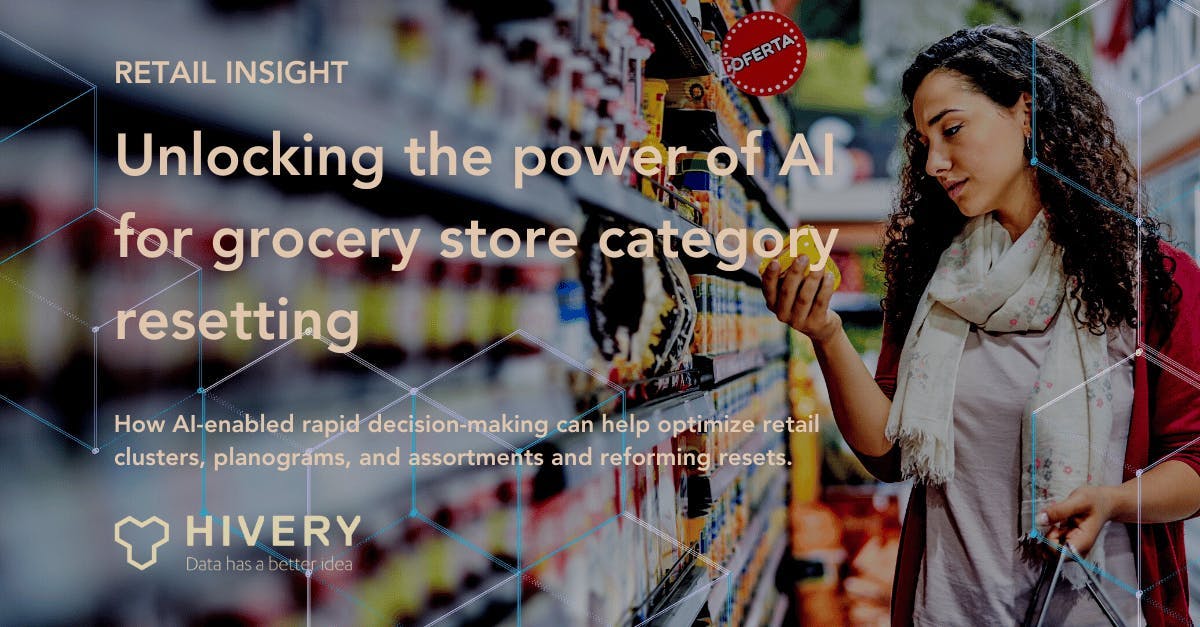
Unlocking the power of AI for grocery store category resetting
Retail Reset Challenges: A Look Inside typical grocery retailer
How AI-enabled rapid decision-making can help optimize retail clusters, planograms, and assortments and reforming resets.
Introduction: Challenges in reset and category planning
Staying ahead in the competitive retail industry requires being prepared for the unknown. However, predicting future demand is difficult due to the ever-changing supply chain. Making accurate assortment predictions at the store level can give a business an edge in the industry.
Any category manager would agree when it comes to managing any grocery department, and it will have its own set of challenges. One of the biggest tasks at hand is the process of resetting categories within the store. This process can take up to 40 weeks and involves a multitude of steps, from preparing for new items to receiving presentations from suppliers. But the actual build process, from start to finish, can take even longer.
For example, one of our clients is working on a cookie and cracker category reset, with everything due for space by February 6th. The reset will go live in the middle of June. Some six months later. This timeline may seem consistent, but new challenges always arise for each retailer during this phase; six months is a long time, and shopper trends can be rapid and dramatic.
A big part of this process is collaboration and iteration before the final reset is delivered. Like many retailers, merchandise and category teams will receive planogram samples from their suppliers early on in the process to ensure the flow and alignment are correct. However, after that initial meeting, it's primarily up to the supplier team to make decisions and build the reset. At the same time, retailers allow suppliers to make calls in the interest of category growth. The retailer buyer and/or merchandising team may request specific items to be included; this means re-running the process again, but if the supplier category team has over-sorted, they must make the final decisions on which items to cut based on performance. This performance decision is critical, but suppliers typically review historical data. They often do not factor in other significant constraints, such as days of supply, food expiry, or even DC slotting requirements. With AI, we can simulate the impact of that retailer's request. In fact, it's such a popular request we have a special rule in our AI model to cater for such events. The rule is called "forced-in" and can tell retailers the impact of that decision - all within minutes.
One objective retailer often shares with us is how to get better with more planograms that make sense to clusters. This can be a challenge as it comes down to feasibility and whether or not the team can actually do it right. Additionally, the team must consider if the planogram is genuinely incremental to the space and if they will realize the financial benefit.
Here is the crucial point: Do current planograms and clusters make sense? Different stores have different shoppers. They seek different brands and pack sizes and need differences in days of supply. A great example we have seen often is retail clients putting a price premium in a lower-income store because they can't change that cluster. After all, all the other products still make sense. This is where AI again can help, and something like HIVERY Curate does well. Right products in the right clusters in the right stores and done quickly.
Changing your processes to leverage new ways.
One of the things that we see quite a bit from grocery leaders as we get into this is most times, they only get a little iteration and quantify assortment and clusters strategies. They do not have the time or process. What If AI can do this rapidly (minutes, not months), optimizing clusters at the store level and ensuring your planograms better reflect your shoppers; would you add it into your process?
For example, one client in the beer category had two yearly resets. In the reset process, they had validation sessions. Here they reviewed planograms to ensure consumer shopping patterns were being considered and constraints and rules were followed to give them the correct planogram flow. The team grouped the products into several tiers and constantly evaluated if the groupings were correct, adjusting as needed to ensure that the process was not broken. This is a very time-consuming activity. With HIVERY Curate, it’s not.
Conclusion
Overall, the process of resetting categories within a retail store can be a long and challenging task. Still, with the right team and collaboration, it's possible to deliver a successful reset that meets the needs of both the retailer and the customer. Ultimately, consumers vote in stores with their wallets. At HIVERY, we believe that leveraging data in the right way with AI models that understand rules and constraints is the future and that Data has a better idea™.
Related resources you might be interested in:
Blog: Do Current Assortment Optimization Methods Create Store Sacrifices?
Blog: Demand Sensing: The New Era of Retail Demand Planning